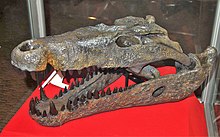
Back ميكوسوتشينا ARZ Mekosuchinae German Mekosuchinae Spanish Mekosuchinae French מקוסוכיניים HE Mekosuchinae ID Mekosuchinae Italian Mekosuchidae Dutch Mekosuchinae NB Мекозухії Ukrainian
| Mekosuchinae | |
|---|---|

| |
| Restoration of the skull of Quinkana timara at the Central Australian Museum | |
| Scientific classification | |
| Domain: | Eukaryota |
| Kingdom: | Animalia |
| Phylum: | Chordata |
| Class: | Reptilia |
| Clade: | Archosauromorpha |
| Clade: | Archosauriformes |
| Order: | Crocodilia |
| Clade: | †Mekosuchinae Willis, Molnar & Scanlon, 1993 |
| Type species | |
| †Mekosuchus inexpectatus Balouet & Buffetaut, 1987
| |
| Genera | |
Mekosuchinae is an extinct clade of crocodilians from the Cenozoic of Australasia. They represented the dominant group of crocodilians in the region during most of the Cenozoic.[1] They first appear in the fossil record in the Eocene in Australia, and survived until the arrival of humans: in the Late Pleistocene in Australia and within the Holocene in the Pacific islands of Fiji, New Caledonia and Vanuatu.
Mekosuchine crocodiles are a diverse group. One of the last species, Mekosuchus inexpectatus from Holocene New Caledonia, may have been arboreal.[2] The early Miocene species Harpacochampsa camfieldensis may have resembled a false gharial. Another mekosuchine fossil, currently undescribed, has been found in Miocene deposits from New Zealand. One genus, Mekosuchus, managed to spread to the islands of the Pacific; it is believed to have island-hopped across the Coral Sea, moving first to a now submerged island known as Greater Chesterfield Island, then New Caledonia and onwards. In the Pleistocene, Quinkana was one of the top terrestrial predators of the Australian continent.
Mekosuchines underwent a drastic decline in post-Miocene Australia, with all genera, except for Quinkana and Paludirex (both perishing during the Quaternary extinction event) becoming extinct in Australia by the end of the Pliocene. After the demise of Quinkana and Pallimnarchus, the group survived on Vanuatu and New Caledonia until the arrival of humans, who are presumed to have driven them to extinction.
While historically considered to be true crocodiles (of the family Crocodylidae), modern research places them as an independent group within or closely related to Longirostres, which contains both crocodiles and gavialids.[1]
- ^ a b Ristevski, Jorgo; Weisbecker, Vera; Scanlon, John D.; Price, Gilbert J.; Salisbury, Steven W. (February 2023). "Cranial anatomy of the mekosuchine crocodylian Trilophosuchus rackhami Willis, 1993". The Anatomical Record. 306 (2): 239–297. doi:10.1002/ar.25050. ISSN 1932-8486. PMC 10086963. PMID 36054424.
- ^ Naish, Darren (13 May 2009). "The small, recently extinct, island-dwelling crocodilians of the south Pacific". Tetrapod Zoology. ScienceBlogs. Retrieved 27 November 2010.
© MMXXIII Rich X Search. We shall prevail. All rights reserved. Rich X Search